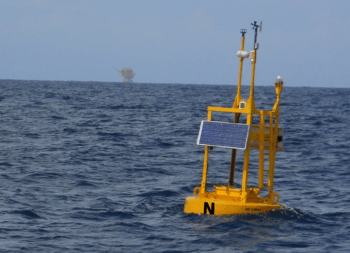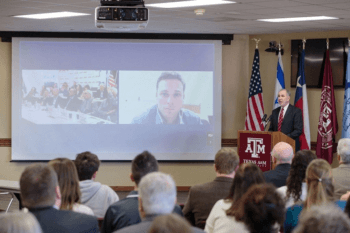Texas A&M, University Of Haifa Announce Major Agreement

Texas A&M University and the University of Haifa announced today their plans to establish a major Mediterranean observatory to capitalize on the oceanographic and atmospheric strengths of the two institutions and build on existing teaching and research in the Gulf of Mexico.
The agreement, totaling more than $5.5 M in initial investments, will be known as the “Texas A&M – University of Haifa Eastern Mediterranean Observatory” (“THEMO”). The observatory will be located at the University of Haifa with its access to critical Mediterranean coastal regions, while drawing on instrumentation and analytical expertise of Texas A&M University faculty and their similar research initiatives in the Gulf of Mexico.
While separated geographically by half a world, the Gulf of Mexico and the Mediterranean Sea are viewed as similar bodies of water and thus provide unique opportunities for comparative analysis of their related impacts on the environment, industry and people of their regions.
“This teaching and research partnership is a critical step for Texas A&M University on its way to becoming a $1 billion-a-year research giant,” said John Sharp, Chancellor of The Texas A&M University System. “Who wouldn’t want to work with Israel — literally the subject of the book “Start-up Nation”— where innovation is not only necessary, it is valued?”

Texas A&M University President Michael K. Young, who formally signed the underlying memorandum of understanding between the two universities, said: “This project is yet another example of Texas A&M’s leadership in addressing the global challenges of our time. It is this type of partnership among our faculty and their colleagues around the world at leading institutions, such as the University of Haifa, that will bring about knowledge needed for lasting change.”
Amos Shapira, President of the University of Haifa, said there are many benefits to working together.
“This collaboration with one of the biggest and best universities in the United States strengthens the role of the University of Haifa as the leading university in Israel in the field of marine sciences,” said President Shapira. “Our understanding on what is happening in the deep water around Israel’s shores is one of strategic importance because the sea is the future of the state of Israel and all of humanity.”
The strategic and scientific venture connects common environmental interests of the two university sites through the monitoring and comparison of processes associated with two similar bodies of water – the Gulf of Mexico and the Eastern Mediterranean Sea. Led by faculty of the College of Geosciences at Texas A&M University, the project will be multidisciplinary, drawing on expertise from various fields and disciplines.
“Understanding how the ever-changing oceans, biota and atmosphere affect humankind is one of the great global challenges of the next several decades, and scientists at both universities are addressing the challenge by sharing resources,” said Kate Miller, Dean of the College of Geosciences at Texas A&M University.
Dr. Tony Knap, Director of the Geochemical and Environmental Research Group, professor of oceanography and Texas A&M University’s principal investigator for the endeavor, said: “The role that oceans play in storing and releasing heat, the consequent effects on sea level and precipitation on land and the relationship between water availability and energy are key in effectively managing the health, safety and financial well-being of our societies.”
The observatory, a shore-based facility to be established at the University of Haifa, will receive and transmit data from two moorings in the Levant Basin of the eastern Mediterranean Sea. University of Haifa officials and faculty were successful in receiving the first of these permissions among the many entities that share governance responsibilities in the Mediterranean Sea to allow this research. Commencing in 2016, implementation is expected to involve over 20 faculty members from the two institutions, although that number is expected to grow as the data can be utilized in multi-disciplinary research.

While the data collection, analysis, modeling and research will be critical to the coastal populations that depend on them for food and energy resources, the faculty also hopes to draw comparisons from the Gulf of Mexico data and modeling that has been underway for some time. In future projects, the goal of this ocean observatory could allow for advanced weather and sea level forecasting, improved ecosystem science and management, hazards prevention and disaster recovery, and enhanced understanding of regions and their adjoining coastal environments.
Texas A&M University’s College of Geosciences has been a pioneer in Earth Sciences, beginning with mapping of ocean floors, scientific ocean drilling programs and the establishment of a similar observatory, The Texas Automated Buoy System, for the Gulf of Mexico in partnership with the Texas General Land Office Oil Spill Prevention & Response in 1995. Conversations are underway to expand the Gulf of Mexico observatory to include partners in Mexico and the Caribbean.
Similarly, both bodies of water have profound impacts on the weather, climate, ecosystem, resources, and economy of the 50 million people who live in Texas and other Gulf of Mexico states, as well as the 100 million people who live in the Levant.
“This collaboration will promote our marine research at the University of Haifa significantly and it is another step in our vast investment in marine science. Only a few months ago we inaugurated our new labs for research of shallow waters, and now we will be able to deepen our vision into the deep ocean,” said Professor David Faragi, the Rector of the University of Haifa. “Texas A&M University is known as a global leading institution with expert faculty and programs in a range of fields that complement the efforts of the University of Haifa. Our hope is that this effort can become a robust research and teaching program.”
In addition to establishing the observatory and instrumentation, faculty and student exchange is a critical part of the project. Faculty from both institutions will participate in regular joint symposium and data modeling sessions. Graduate and undergraduate students will have opportunities to participate in courses within each university’s area of specialization, to utilize real-time data to advance research projects and to help educate the public as part of the outreach and service missions of each university.
Media contact: tamunews@tamu.edu.





